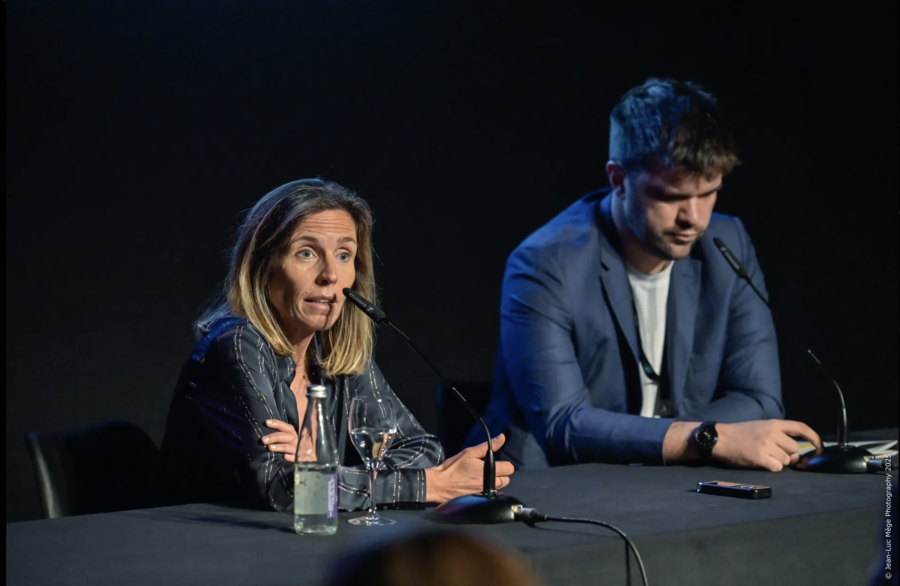Guest of Honor Interview : Justine Ryst (Managing Director, YouTube France and Southern Europe)
The masterclass given by Justine Ryst, General Manager of YouTube France and Southern Europe, hosted by Florian Krieg (Editor-in-Chief of Le Film Français), addresses the platform's central role in enhancing cinematic heritage, its transmission to new generations, and its support for the industry, structured around the protection of rights and an established economic model.

I. YouTube as an Extension of Cinephilia and Discoverability
YouTube has established itself as a natural space for cinema, particularly revitalizing cinephilia among younger generations.
-
New Criticism and Transmission: Cinephilia extends and reproduces itself on YouTube thanks to highly in-depth analysis channels (cited: Calmos, Le Fossoyeur de Films, Sofyan...). These creators offer a new form of criticism, sparking interest and a "surge in consumption" for heritage films (e.g., Chao Pantin).
-
Support for the Theatrical Experience: YouTube is rooted in the French cultural exception and seeks to support the collective experience of cinema. The YouTube Ciné Club (in partnership with Mk2 and Elisha Karmitz) illustrates the success of the theatrical experience among young people, especially for previews of works by YouTube creators.
-
"In Real Life" Discoverability: Initiatives such as the CNC Talent residency at the Cannes Festival connect young talents and cinephiles with industry professionals, promoting discoverability beyond the screen.
II. Rights Protection and Economic Model for Creation
YouTube's commitment to cinema is based on protecting works and sharing value equitably.
-
Fight Against Piracy: The essential tool is Content ID, an internally developed digital fingerprinting system. It allows rights holders to precisely configure their exploitation rules (prohibition, authorization, monetization), regardless of content format.
-
The system has paid over $12 billion to rights holders since its creation. An agreement with ALPA and the CNC ensures easier access to this tool for independent studios.
-
The tool manages territorial rights, enabling precise application of exploitation rules based on location.
-
-
Economic Model and Value Sharing: The free access model funded by advertising is the pillar of economic sustainability.
-
YouTube reverses more than half of its advertising revenue to channel owners, fueling the Creator Economy.
-
This economy significantly contributes to French GDP (€850 million) and generates jobs.
-
Films are also available for rental or purchase, representing 10 million titles.
-
The platform enables studio catalogs (Gaumont, Pathé, etc.) to experience a "re-incarnation" (a 3rd, 4th, 5th life) for works no longer on air or in theaters.
III. Exploitation Strategy and International Reach
Rights holders are encouraged to adopt a digital strategy for the long term, relying on powerful analytics tools.
-
Roadmap for Presence: The first step is activating Content ID for protection. Rights holders can then launch their own regular YouTube channel (requiring consistency and a deep catalog) or partner with specialized aggregators (e.g., Allociné Box Office, Logicomix) who manage distribution and editorialization.
-
Success Case Studies: INA (French National Audiovisual Institute - with over 50 channels) is praised for its multi-format and agile strategy. Arte Film is also cited for its successful coordination between broadcast, its website (Arte.tv), and YouTube, allowing them to reach different audiences (Arte's YouTube audience being younger).
-
Audience Analysis Tools: The YouTube Studio tool provides rights holders with granular data (watch time, peak viewing, traffic source) enabling true "audience engineering" essential for content optimization.
-
Export and Accessibility: YouTube is a tremendous export window, particularly towards Francophone territories. Automatic subtitling and AI dubbing technologies are key features for having works travel and building a direct, measurable community asset for rights holders.




